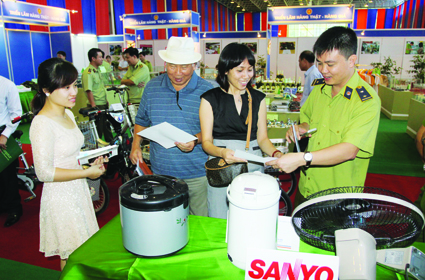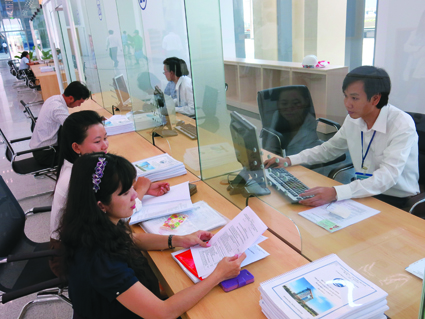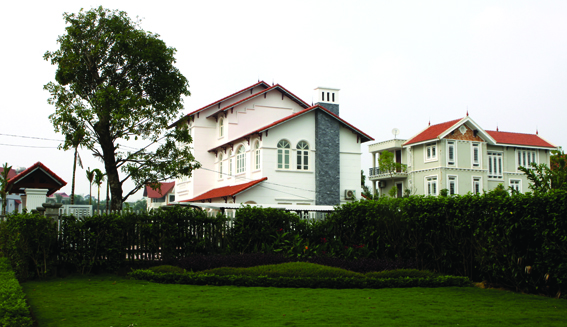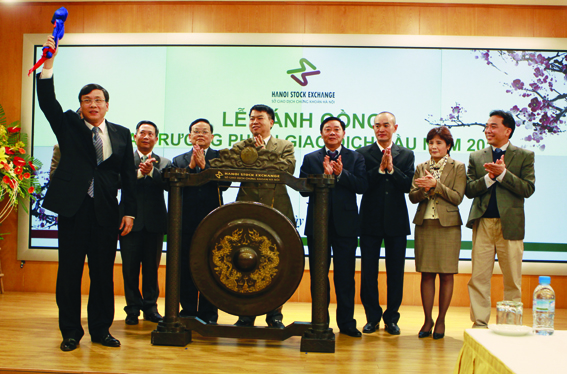Nguyen Thi Lan Anh*
Tension in the East Sea (internationally referred to as the South China Sea) region reached its peak level the past two years. New occupation, new claims, arrest of fishing vessels and other incidents have complicated the disputes in the East Sea. The parties concerned not only exchanged harsh words directly at each other, but also are preparing for the worst-case scenario of using force, evidenced by their increasing military expenditures. This situation was blamed on the incapability of the DOC in conflict management and its lack of binding effect to ensure self-restraint and implementation of the signatories. This also gave rise to the urgent need of a binding code of conduct (COC). This paper will justify the necessity of a legally binding COC, its desirable scope of application, main elements as well as provide some thought on the way to achieve the future COC.

The necessity of a legally binding COC
The idea of building a Code of Conduct for the East Sea emerged from 1992 when China enacted its Law on the Territorial Sea and the Contiguous Zone and signed a contract with the US Crestone Oil Company. The law states that the territorial land of China includes “… the Dongsha (Pratas) Islands, the Xisha (Paracels) Islands, the Nansha (Spratlys) Islands and other islands that belong to the People’s Republic of China”.[1] China expressed its willingness to use naval forces to enforce the contract with Crestone in the area claimed as continental shelf of the mainland of Vietnam. In response to these aggressive acts of China, the foreign ministers of the member states of ASEAN issued the Declaration on the East Sea in July 1992 urging all the concerned parties to solve the dispute by peaceful means and to build a code of international conduct in the East Sea.[2]
After the 1992 Declaration, the formulation and drafting of the Code of Conduct were discussed in the meetings of ASEAN Summit Meeting, ASEAN Ministerial Meeting, ASEAN Regional Forum (ARF), the Workshops on Managing Potential Conflicts in the East Sea and the Technical Working Group on Legal Matters. The discussions lasted seven years from 1992 to 1999. During the discussions, the two bilateral Codes of Conduct, which China signed with the Philippines and Vietnam in 1995, were considered an example of how the Code of Conduct for the East Sea would be drafted.[3]
In 1999, the Philippines, on behalf of ASEAN countries, prepared a draft COC along with the Chinese draft. However, differences in the positions of China and ASEAN led to the prolongation of the adoption of the Code until November 4, 2002, at the 8th ASEAN Summit.[4] The Code was not adopted with binding effect as expected, as it was only a recommendation under the name of the Declaration on the Conduct of Parties in the East Sea (DOC).
The conclusion of the DOC was hailed by many leaders in the region. President Arroyo called it as a “major Philippine success”[5] while Foreign Minister Blas Ople asserted the DOC as “a strong foundation for future negotiations with China and our other ASEAN partners on maritime security and territorial issues.”[6] Malaysian Prime Minister Mahathir considered that the Code might not have much effect as expected but was “a good agreement.”[7] Vice Foreign Minister of China Wang Yi stated that the DOC would “send a positive signal to the outside world that China and ASEAN have full capability to resolve disputes among themselves, peacefully through dialogue”[8] and that “is a symbol that would lead to new relations between China and ASEAN.”[9] Premier Zhu Rongji also praised the DOC as creating a “high level of political trust” between the two sides.[10]
Notwithstanding the high appreciation and expectation of the parties concerned, the DOC failed to ensure self-restraint and develop confidence building measures. Since the conclusion of the DOC, though no major armed conflicts occurred as in 1988, small incidents such as arrest of fishermen, harassment of scientific vessels and new occupation of submerged features happened frequently with the increasing numbers of cases as well as the numbers of parties involved.[11] Tensions reached the highest level in the first half of 2011 between China, the Philippines and Vietnam leading to strong reactions from the two ASEAN countries. Both the Philippines and Vietnam allocated new spending for military expenditure and demonstrated high alert on the threats to use force from China.[12] The Philippines also expressed determination to seek resolution for the East Sea dispute at international judicial bodies.[13] Therefore, even though frequently cited as a guidelines for behavior of the parties, with the recent escalation of tensions from 2009, the DOC failed to meet the expectation of the parties. Failing to maintain peace and security, the DOC was blamed as a “dead letter” or being “on life support”.[14]
The failure of the DOC could be due to different causes. First, the silence on the scope of application of the DOC opened for different understandings on the applicable maritime zones, leading to parties arbitrarily accusing each other of violating the terms of the DOC. The difference between ASEAN and China concerning what is disputed in the East Sea is of particular concern. ASEAN considers that the dispute is only limited to the group of islands in the East Sea, while China, by its recent activities, implied that it claims the large area covered by the nine dotted lines, and thus expanded the disputes to the exclusive economic zone and continental shelf of littoral states.[15]
Secondly, the contents provided in the 11 points of the DOC were too generic, without any specific provisions to prevent the acts that could complicate the situation of the dispute. Among the many activities that might escalate the dispute, the Declaration only listed “action of inhabiting on the presently uninhabited islands, reefs, shoals, cays, and other features” that countries has to restrain from. Hence, the stakeholders could arbitrarily invoke the contents of the DOC to justify their actions.[16]
Thirdly, confidence building and cooperation were an emphasis and main purposes of the Declaration reiterated in points 2, 6 and 7. The wording of these points, however, was drafted in a looed manner, containing no mandatory obligations. As a result, no successful measures have been reached to promote trust or cooperation between the parties. In fact, the parties still conducted activities like military exercises, new occupation and construction, etc., to fortify their claims.[17] These activities certainly demolished confidence and good faith of the parties concerned, thus complicated the dispute.
Fourthly, the DOC contained no dispute settlement or performance review mechanisms. The implementation mechanism was referred to in points 8 and 9. Point 8 provided that “the parties concerned stand ready to continue their consultation and dialogues concerning relevant issues, including regular consultations on the observance of the Declaration”. And point 9 states that “the parties undertake to respect the provisions of the Declaration and take actions consistent therewith”. The expressions of “stand ready” and “undertake” were of a soft law manner with no binding force, and thus it was not surprising that there were little compliance with and enforcement on the DOC.
Last but not least, related states were called to respect the principles embodied in the DOC.[18] Unfortunately, as related states except ASEAN countries and China were not the concluding parties, no mechanism available for them to participate in the implementation process of the Declaration.
The limitation of the DOC could be justified from the context of the conclusion of the Declaration. Due to the wide gap between the positions of China and ASEAN, the conclusion of DOC was consideres an initial step towards the development of a binding code of conduct.[19] After some serious incidents in the East Sea in 1988 and 1995, the conclusion of the DOC that embodies important principles and contents of international law with the engagement of China was indeed an encouraging achievement.
The current situation, however, has changed. The new round of tension arose due to more assertive policies of some claimants. New claims were introduced that place most of the East Sea under dispute. With many weaknesses, the DOC has shown its incapacity in managing the dispute and therefore, the stability of the region is endangered. This gave rise to the need for a binding Code of Conduct.
Scope of the desired COC
To address the primary weakness of the DOC, the COC must have a defined scope of application. One of the arguments relating to the scope of the COC is the whole of the East Sea.[20] The advantage of this option is that it inherits the scope of the DOC. The DOC, although containing no specific provisions on the scope of application, mentioned the two archipelagoes, the Paracels and Spratlys. And by this indication, the parties seemingly supported that the DOC’s zone of application covers the entire East Sea. However, the vital point was that by mentioning only the Paracels and Spratlys, the DOC limited itself to the disputes over the sovereignty of these islands. Meanwhile, by referring to the whole of the East Sea, the future COC will cover both disputed islands as well as maritime spaces. The parties may reach agreement that the islands of the Paracels and Spratlys are in dispute, but will disagree that the whole maritime spaces of the East Sea are in dispute. Therefore, this approach may have the support of China but concern will come from the other littoral states, such as the concern “disp-isze” their maritime zones. One solution to overcome this problem is to apply international law to segregate the disputed and non-disputed areas.[21] As a result, the COC may have different “codes” according to different legal regimes that regulate different maritime zones.

The other alternative for the scope of the future COC is to have a general COC for both the East Sea and East China Sea, as the two oceans are interconnected, at least on thaloverall environment, the disputes and the related parties. Japan and China have interests in both seas. Some Chinese scholars recently considered the East Sea and East China Sea as the samrycategory of interests. However, China should adopt a new strategic view, expand its interests to the broad high sea and should not just limed itself within the surrounding seas.[22] With such a new approach, China may support a wide-scope COC. For Japan, it has interests in free navigation from the East Sea to the East China Sea. In addition, the disputes in both seas are related to similar legal questions of sovereignty to islands and entitlement to maritime zones of the islands. The tension caused by sovereignty and sovereign rights claims in both seas need to be properly managed. Japan recently is very keen on establishing a maritime security forum.[23] However, the more parties are involved, the more difficult it is for the future COC to be negotiated and concluded. Furthermore, one of the key legal questions is that the legal regime of islands is interpreted and applied inconsistently in the two oceans.[24] This may prevent any feasible approach to arrive at this alternative even if the parties concerned may take this into consideration.
Main elements of the content of the future COC
As a legally binding document, the COC is expected to provide mechanisms for promoting cooperation and managing conflicts and ensuring the enforcement among parties. Accordingly the future COC must contain, but not limited to, these elements: general principles, prohibited activities, cooperation and enforcement mechanisms.
The general principles of the future COC may be inherited from the DOC and consists of the following principles:[25]
Respect for international law, particularly the 1982 United Nation Convention on the Law of the Sea
Respect for regional commitment including TAC and DOC
Settlement of disputes by peaceful means, no use or threat to use of force
The prohibited activities should cover all activities that escalate the disputes or put the security of the region in danger, among them are constructing new structures, undertaking new occupation, conducting unilateral military exercise in sensitive areas, harassing or obstructing the legitimate sovereignty rights of littoral states, etc.[26]
The cooperation mechanism should outline the main cooperation fields, namely marine scientific research, marine environment protection, freedom and safety of navigation, on suppression of transnational crimes and crimes at sea, cooperation in fishery and joint development in hydrocarbon resources.[27] In each field, the ideal outcome of the future COC is to establish main cooperation principles and develop the mechanism for further discussions and negotiation between the parties. The detailed provisions for cooperation in each field may be elaborated in subsequent agreements.[28]
The enforcement mechanism should provide confidence building measures, conflict management and dispute settlement mechanisms. Confidence building is the first and foremost element in the current context in order to ensure the implementation of the COC. Measures to promote joint research, exchange scholars, researchers, jointly organize workshop, enhance information sharing, etc., are activities that the future COC may include for building trust and confidence among parties. In this connection, conflict management is also an important part that the future COC should be focused. Conflict emerges as a result of the loose DOC’s provisions on self-restraints. The COC may correct this weakness by being more specific, such as by listing all activities is seen as not being in restraint. Also, it may identify relevant bodies and mechanisms to promptly exchange information on incidents as well as provide procedures for diplomacy, e.g., mediation, inquiry or conciliation to defuse the tension and prevent the incidents from escalating. Finally, dispute settlement mechanisms in the form of monitoring and periodic review of implementation should be included to ensure transparency and thus encourage implementation of the parties.[29] In addition, the future COC may also make references to current international dispute settlement mechanisms on a voluntary basis in order to provide further options for the parties.[30]
The way to achieve a future COC
Concerning formality, any future COC can only be concluded if it successfully gathers the support of the current parties of the DOC. To that extent, the lesson learned from the conclusion of the DOC is valuable and the current mechanism involving ASEAN and China relating to the DOC should be made use of. A Technical working group on the COC should be established and assigned the task of conducting research and making proposals on the draft of COC.[31] For greater focus and proper use of deep expertise, several committees can be established in charge of conducting research on various potential issues and contents of the future COC.[32] The COC should be placed on the agenda of regular and ad-hoc meetings of the ASEAN Senior Official Meeting on the implementation of the DOC.[33] It may also be developed as a topic for discussions in broader fora, e.g., ASEAN Regional Region and East Asia Summit. In addition to the formal (track 1) channel, the brainstorming on the future COC should be encouraged in informal channels (track 1.5 or 2) in order to bring “food for thought” into track 1.[34] In addition, in order to facilitate the adoption and support of the parties, the initiative and draft of the COC should be consulted among firstly ASEAN countries, than with China and finally with other related states.
Regarding substantial issues, marine scientific research, marine environment protection, freedom and safety of navigation, on suppression of transnational crimes’ and crimes at sea, cooperation in fishery and joint development in hydrocarbon resources are potential areas for cooperation. However, experiences drawn from the effort initiated by Indonesia under a series of workshop on managing potential conflict in the East Sea since 1990s indicated that cooperation in fisheries and joint development in hydrocarbon resources are highly sensitive due to the issue of sovereignty claims.[35] Even marine scientific research in the form of joint seismic survey used to be undertaken between China, the Philippines and Vietnam in 2005. This raised the hope of subsequent substantial cooperation, however the project was suspended indefinitely due to sovereignty issues.[36] In this regard, the COC should not be aimed at developing detailed agreement for all areas. The main task of the COC is to set out the general principles for cooperation and a forum for the parties to further negotiate and discuss. The COC should focus primarily on the less sensitive areas of freedom and safety navigation, on suppression of crimes and environmental protection. These are also areas that the parties have common interests on and are relatively easier to reach consensus at. In order to avoid sovereignty issues, the COC should also take a gradual build-up approach. Accordingly, the COC should be an opened legal document that can be supported by subsequent annexes in the form of cooperation agreement or MOU in each field. Failing to reach an agreement in one field of cooperation will not block the implementation of the COC, as well as not prevent the parties to continuously negotiate in other fields.
All in all, a binding code of conduct is desirable and necessary to correct the weaknesses of the DOC and better work for maintaining peace and security as well as promote cooperation of the region. In order to arrive at such a desired COC, it is recommendable that the future COC should govern the entire East Sea with some core elements, including general principles, prohibited activities, cooperation mechanism and enforcement measures. It took seven years for the parties concerned to arrive at a suggestive DOC. Hence, it is expected that a binding COC will not be achieved overnight. However, the time can be shortened if the parties take a flexible approach on the content as well as devote their good will and constructive attitude in the negotiation and consultation process. In order to achieve this, the current mechanisms of ASEAN and ASEAN plus, the ARF and EAS should be made use of and the ASEAN working group on the DOC should be assigned the role of conducting research and drafting the COC. Discussions in track II should also be encouraged to facilitate the discussion in track I. It is hoped that with all the effort and good will, ASEAN will meet the target of reaching an agreement on the COC by the time an ASEAN Community is formed in 2015.-
* Institute for East Sea/South China Sea Studies, Diplomatic Academy of Vietnam. The view expressed in this paper is her own.
[1] Article 2 of the Law on the Territorial Sea and the Contiguous Zone on February 25, 1992. For full text, see https://www.un.org/Depts/los/LEGISLATIONANDTREATIES/PDFFILES/CHN_1992_Law.pdf (accessed on October 21, 2005).
[2] Paragraphs 1 and 4 of the ASEAN Declaration on the South China Sea, Manila, Philippines, July 22, 1992. For full text of the Declaration, see website of the ASEAN Secretariat: https://www.aseansec.org/3634.htm (accessed on October 21, 2005).
[3] The two Codes of Conduct were signed in August and November 1995 respectively.
[4] The two drafts contained some differences. China wanted the Code to apply to the Spratlys only and any solutions to the dispute should be dealt with through bilateral negotiations. While ASEAN members preferred that the Code would apply to both the Paracels and Spratlys and the dispute would be solved through multilateral negotiation. The ASEAN draft also emphasized refraining from inhabiting and erecting structures on presently inhabited islands, reefs, shoals, cays, and other features in the disputed area while China’s draft was silent on this issue. For discussion, see Yann-huei Song, “Codes of conduct in the South China Sea and Taiwan’s Stand” 24 (2000) Marine Policy, 449 at 445.
[5] Quoted in Genalyn D. Kabiling, “Accord on South China Sea dispute hailed”, Manila Bulletin, November 4, 2002.
[6] Department of Foreign Affairs, The Philippines, “Ople Lauds Signing of Declaration on the Conduct of Parties in the South China Sea”, Press Release No. 246-02, November 4, 2002.
[7] Chih-ji Hsiu, “Why Code of Conduct failed? China and ASEAN in South China Sea dispute” available at https://www.wiscnetwork.org/porto2011/papers/WISC_2011-754.pdf (accessed on October 13, 2011).
[8] Quoted in Dona Pazzibugan, “Spratly pact hailed as RP success” and “Editorial and Opinions: Beyond Terrorism”, Philippine Daily Inquirer, November 4, 2002.
[9] Quoted in Ian Storey, Implementing CBMS in the 2002 DOC: A roadmap to managing the South China Sea Dispute, paper presented at the Second International Workshop on South China Sea, Ho Chi Minh City, November 2010, available at https://nghiencuubiendong.vn/en/conferences-and-seminars-/second-international-workshop/602-602- (accessed on September 27, 2011).
[10] Francesco Sisci, “The Spratlys pact: Beijing’s olive branch”, Asia Times, 6 November 2002, available at https://www.atimes.com/atimes/china/DK06Ad01.html (accessed on October 13, 2011).
[11] For reviews of recent developments and their implication to security of the region, see Carlyle A. Thayer, “Security Cooperation of the South China Sea: An Assessment of Recent of Trends”, Presentation at Conference on the South China, Manila, July 5-6, 2011.
[12] Philippines have invested USD 183 million to defend the Spratlys, in addition to earlier spending of USD 225 million to the arms forces. See Jon Grevatt, “Philippines to invest USD 183 million in defence of Spratly Islands,” Jane’s Defence Weekly, March 30, 2011; Reuters, “Philippines steps up presence in South China Sea,” March 28, 2011 and Associated Press, “Philippines to bolster watch in disputed Spratlys,” Bloomberg Businessweek, March 28, 2011 and Reuters, “Philippines says will spend $255 min on military helicopters, boats,” April 13, 2011.
[13] During a visit to Beijing in July 2011, Philippines Foreign Minister Albert del Rosario proposed that the parties concerned submit their dispute in the South China Sea to the International Tribunal on the Law of the Sea. However, China has refused by insisting that “the South China Sea dispute should be resolved through direct negotiations between related parties in accordance with historical facts and widely recognised international law”, said by Foreign Ministry spokesman Hong Lei at a regular news briefing. See Li Xiaokun and Ma Liyao, “Bilateral talks ‘best way’ to solve dispute”, China Daily, July 15, 2011.
[14] Ian Storey, op.cit., note 9.
[15] In order to express its opposition to the submission on the extended continental shelf of Vietnam and Malaysia, China sent two Note Verbales No. CML/17/2009 and CML/18/2009 dated May 7, 2009, to the United Nations. The nine dotted lines were attached in the Note Verbal without concrete interpretation. This was a first time that such lines were included in an official international document of the Chinese Government. Then, in this series of respondent, China also sent another Note Verbal No. CML/8/2011 dated April 14, 2011 to claim for the first time that the Spratlys have exclusive economic zone and continental shelf.
[16] E.g., after the harassment incidents occurred within the exclusive economic zone of Vietnam, China interpreted that “what relevant Chinese departments did was completely normal marine law-enforcement and surveillance activities in China’s jurisdictional area.” Quoted in Reuters, “China reprimands Vietnam over offshore oil exploration,” May 28, 2011.
[17] China, by the two Note Verbales, see op.cit., note 15, declared its new claims of the nine dash lines and the full maritime zone of the Spratlys. China also unloaded some structure on some submerged feature in the Philippines waters. For details, see Pia Lee-Brago, “China Building in PHL Waters; DFA Summoned Envoy,” The Philippine Star, June 2, 2011.
[18] Point 10 of the DOC stated that the Parties encourage other countries to respect the principle contained in this Declaration.
[19] HT Nguyen, “The 2002 Declaration on the Conduct of Parties in the South China Sea: A Note”, 34 (2003) Ocean Development and International Law, 279.
[20] TH Nguyen and T Nguyen Dang, “The Code of Conduct in the South China Se: The International Law Perspective”, International Studies, p.13.
[21] This idea is also in line with point 3 of the Guidelines for the Implementation of DOC that the implementation of activities or projects as provided for in DOC should be clearly clarified.
[22] Viewpoints of Chinese scholars in round-table discussion on South China Sea and strategic interests of China. Available online at https://gb.chinareviewnews.com/crn-webapp/mag/docDetail.jsp?coluid=61&docid=101816170&page=1 (accessed on October 11, 2011).
[23] Ly do Nhat Ban day manh thanh lap dien dan an ninh tren bien, Hoang Anh gather from Neikike source, available on https://nghiencuubiendong.vn/tin-ncbd/2118-ly-do-nht-bn-y-nhanh-y-tng-thanh-lp-din-an-an-ninh-bin (accessed on October 14, 2011).
[24] The Okinororishima Island and islands of the Spratlys are very similar in terms of their sizes and natural conditions. The former was opposed to be have full maritime zones; however, the latter was claimed full maritime zones.
[25] Point 1, 3 and 4 of the DOC.
[26] One of the ideas that help to develop details provisions on the conducts of the parties concerned according to disputed and non-disputed areas. These areas can be segregated by applying international law on legal regime of islands and maritime delimitation under the ZoPFF/C initiative of the Philippines. Accordingly ZoPFF/C may be integrated as a supplementing measure in COC.
[27] Pending for a final solution on sovereignty issues, the development of cooperation mechanisms will help the parties concerned fulfil their obligations of reaching temporary arrangement under Articles 74(3) and 83(3) and of cooperation in a semi-enclosed sea under Article 123 of UNCLOS.
[28] E.g. Valencia suggested a Guidelines on military activities in foreign EEZs as one of possible further developments beyond general provisions of DOC, see Valencia, “Beyond DOC: Guidelines on military activities in foreign EEZs”, presentation at “Conference on the South China Sea: Toward a Region of Peace, Cooperation and Progress”, co-sponsored by the Foreign Service Institute and the Diplomatic Academy of Vietnam, Manila, the Philippines, July 5-6, 2011.
[29] This mechanism can be developed by drawing experience from reviewing procedures of the UN mechanism on human rights, e.g. universal periodical review under the Human Rights Council.
[30] In this regard, Article 187 of UNCLOS can provide for an analogy application. However, the dispute settlement mechanism of the future COC may not made reference to a mandatory forum as the last alternative if the parties otherwise agree.
[31] The Working Group on DOC was established in 2004 and its ToR did not provide for the task of conducting research and formulating recommendations on COC. However, point 129 of the Chair’s Statement of the 18th ASEAN Summit Jakarta dated May 7-8, 2011, has specified the target of initiating the discussion on a regional COC. It was also reported that in the 18th ASEAN Summit, the agreement on establishing a working group on COC was reached at the informal ASEAN Ministerial Meeting on the sidelines of the 66th session of the United Nations General Assembly in New York on September 24, 2011, said by Vietnamese spokesman Luong Thanh Nghi at the Vietnamese Foreign Ministry’s regular briefing in Hanoi on October 6, 2011.
[32] This idea can be learned form the Antarctica Treaty and recently supported by China in some closed discussion.
[33] In some recent meetings, COC has been included in the agenda. This trend should be encouraged in order to meet the target of achieving agreement between ASEAN countries on a regional COC, see point 129 of the Chair’s Statement of the 18th ASEAN Summit Jakarta dated May 7-8, 2011.
[34] This should be done foremost among the network of ASEAN Institute of Strategic and International Studies. Indeed, in the past few months the discussion on COC has been formulated in ASEAN ISIS and draw broad attention and initiatives. Such discussion can be further promoted with broader participants and with possible engagement of countries that have related interests, such as Japan and India.
[35] For the opinion of how sovereignty can be deadlock for cooperation, see Hasjim Djala, “South China Sea: Contribution of 2nd Track Diplomacy/Workshop Process to Regional Peace and Cooperation”, Paper presented at Workshop entitled “Entering Uncharted waters? ASEAN and the South China Sea dispute”, organized by the Institute for Southeast Asia Studies, Singapore, February 18, 2011.
[36] One of the reasons that led to the end of the tripartite seismic agreement was the blame that??? approximately one-sixth of the area designated for the seismic survey laid within the Philippines’ territorial waters, and outside the claims of both China and Vietnam. See Ian Storey and Carlyle A. Thayer, “The South China Sea Dispute: A Review of Developments and their Implications since the 2002 Declaration on the Conduct of Parties”, Paper presented at the First International Workshop on the South China Sea, co-organized by the Diplomatic Academy of Vietnam and Vietnam Lawyers’ Association, Hanoi, 2009; also see, “Joint exploration pact lapses” Philippines Stars, July 12, 2008.






